
Make Out-of-America Great Again: Humans in the New World at 24,000 YBP
PLoS ONE 12(1): e0169486. doi:10.1371/journal.pone.0169486 Earliest Human Presence in North America Dated to the Last Glacial Maximum: New Radiocarbon Dates from Bluefish Caves, Canada Burgeon, Lauriane, Ariane Burke, and Thomas Higham The timing of the first entry of humans into…
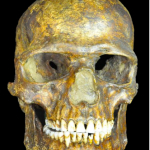
Ancient Kostenki 14 (Markina Gora) DNA: A Glimpse into a Population on Its Way from America to Africa
Science DOI: 10.1126/science.aaa0114 Genomic Structure in Europeans Dating Back at Least 36,200 Years Andaine Seguin-Orlando, Thorfinn S. Korneliussen, Martin Sikora, Anna-Sapfo Malaspinas, Andrea Manica, Ida Moltke, Anders Albrechtsen, Amy Ko, Ashot Margaryan, Vyacheslav Moiseyev, Ted Goebel, Michael Westaway, David Lambert,…

Ancient DNA from Mal’ta and Afontova Gora: A Full Account
Courtesy Alexander Kim, the long-awaited paper by the Eske Willerslev team became finally available to me. This is obviously not the last word on the subject of Amerindian origins, and the David Reich Lab has a different interpretation of ancient…
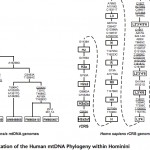
A Closer Look at Human and Neandertal Mitogenomes
In one of my comments on Anthrogenica.com, I mistakenly denied that Behar et al. (2012) reported the two mutations A2758G and G7146A shared between late European Neandertals and the modern human L2’3’4’5’6 clade. As a reminder, A2758G and G7146A were highlighted in…
The End of Out-of-Africa: A Copernican Reassessment of the Patterns of Genetic Variation in the Old World
Over at Anthrogenica, I’ve been having some heated (as always) but this time also productive discussions regarding the interpretation of currently available genetic evidence. In the following I will sketch out a hypothesis that increasingly makes sense to me. 1….
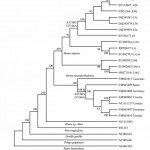
A Signal of Neandertal Admixture in Modern Human mtDNA?
Russian Journal of Genetics, September 2013, Vol. 49, No. 9, 975-978 Mitochondrial DNA Polymorphisms Shared Between Modern Humans and Neanderthals: Adaptive Convergence or Evidence for Interspecific Hybridization Malyarchuk, Boris A. Abstract An analysis of the variability of the nucleotide sequences in the…
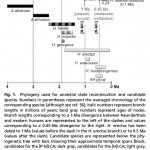
The Last Common Ancestor of Modern Humans and Neandertals Still a Mystery
Proceedings of the National Academy of Sciences, October 21, 2013 doi:10.1073/pnas.1302653110 No Known Hominin Species Matches the Expected Dental Morphology of the Last Common Ancestor of Neanderthals and Modern Humans Gómez-Roblesa, Aida, José María Bermúdez de Castroc, Juan-Luis Arsuaga, Eudald Carbonelle, and P. David…
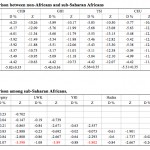
Neandertal Admixture in Africans: A Back-Migration to Sub-Saharan Africa Confirmed
Genome Biology and Evolution 2013 Oct 25. Apparent Variation in Neanderthal Admixture among African Populations is Consistent with Gene Flow from non-African Populations. Shuoguo Wang, Joseph Lachance, Sarah Tishkoff, Jody Hey, and Jinchuan Xing Abstract Recent studies have found evidence of…

An Out-of-America Signal as Seen Through Human Regulatory Genes
PLoS Genet 9(4): e1003404. doi:10.1371/journal.pgen.1003404 Balancing Selection on a Regulatory Region Exhibiting Ancient Variation That Predates Human–Neandertal Divergence Omer Gokcumen, Qihui Zhu, Lubbertus C. F. Mulder, Rebecca C. Iskow, Christian Austermann, Christopher D. Scharer, Towfique Raj, Jeremy M. Boss, Shamil…
Congenital Anomalies, Kinship Systems and Pleistocene Demography
PLoS ONE 8(3): e59587. doi:10.1371/journal.pone.0059587 An Enlarged Parietal Foramen in the Late Archaic Xujiayao 11 Neurocranium from Northern China, and Rare Anomalies among Pleistocene Homo Xiu-Jie Wu,Song Xing, and Erik Trinkaus. We report here a neurocranial abnormality previously undescribed in…
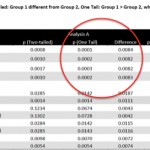
Archaic Admixture in Africa, a Final Solution for Cultural Anthropology and the New World Roots of the Oldest Dog: News from Around the Web
I haven’t been blogging for a while because of a new demanding leadership job. It will keep me busy, so I’m shifting to more of a bite-size blog post format. In the meantime, I’ve been active on Gisele Horvat’s Human…
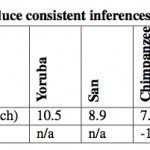
How Europeans Got to Be ~10% American Indian
Genetics doi: 10.1534/genetics.112.145037 Ancient Admixture in Human History Nick Patterson, Priya Moorjani, Yontao Luo, Swapan Mallick, Nadin Rohland, Yiping Zhan, Teri Genschoreck, Teresa Webster, and David Reich Population mixture is an important process in biology. We present a suite of methods…
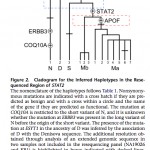
Archaic Introgression and the Derived Nature of African Lineages at STAT2 Gene
American Journal of Human Genetics 91, 2012, 265-274. http://dx.doi.org/10.1016/j.ajhg.2012.06.015. A Haplotype at STAT2 Introgressed from Neanderthals and Serves as a Candidate of Positive Selection in Papua New Guinea Fernando L. Mendez, Joseph C. Watkins, and Michael F. Hammer. Signals of…
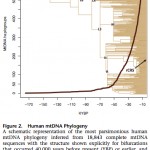
Between Behar et al. 2012 and Johnson et al. 1983: The Mitochondrial DNA Tree Comes of Age but Remains a Blunt Tool for Human Evolutionary History
American Journal of Human Genetics, Volume 90, Issue 4, 675-684, 6 April 2012 doi:10.1016/j.ajhg.2012.03.002 A “Copernican” Reassessment of the Human Mitochondrial DNA Tree from its Root Behar, Doron M., Mannis van Oven, Saharon Rosset, Mait Metspalu, Eva-Liis Loogvali, Nuno M….
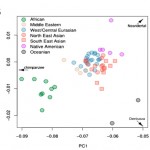
American Indians, Neanderthals and Denisovans: Insights from PCA Views
Dienekes posted a SNP PCA showing the relative position of a sample of modern human populations from the Harvard HGDP along the axes formed by Chimpanzees, Denisovans and Neanderthals. On the broad-view PCA, the red dot indicates Chimpanzees, the green…
Archaic Morphology and American Indian Biological Variability
On the heels of my last post about the possibly systematic trend to ignore American Indian samples in the studies of worldwide variation, there’s a new paper dealing with the discovery of human remains with archaic morphology as late as…
Neanderthals and Amerindians: Intragroup Genetic Diversity and Population Size
John Hawks writes: “Neandertals have strikingly limited genetic variation. They once lived across a range from Spain to Siberia. Yet when we compare sequences across their whole genomes, we find them to be much less different across this geographic range…


Recent Comments